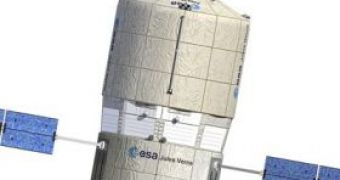Yesterday morning, the ATV Jules Verne executed its scheduled burning maneuver in order to elevate the altitude of the International Space Station. At 06:22 CEST, the ATV Control Center in Toulouse initiated a 740 second burn sequence of Jules Verne's two main engines, able to produce a thrust of 2.65 m/s, thus lifting the space station by 4.5 kilometers. The space laboratory is now orbiting Earth at an altitude of 342 kilometers above ground.
"The station's altitude naturally decreases with atmospheric drag. Until now, this has been compensated for by performing a re-boost using the Russian Progress, the space shuttle of the ISS itself. Today, ATV has successfully demonstrated that it too is able to perform this vital function. Only Progress and the ATV can provide this high level of re-boost. ATV is unique due to the quantity of fuel available for such maneuvers," said ESA Mission Director at ATV-CC, Alberto Novelli.
The Jules Verne ATV was launched into space on 9 March with the help of an Arian 5 rocket from the Kourou space port in the French Guiana. After the departure of the Atlantis space shuttle, it moved from its parking position only to dock with the ISS on 3 April. Aside the 1,150 kilograms of dry cargo it was carrying on board, the ATV also delivered water, oxygen for the artificial atmosphere and fuel for the attitude controls of the station.
It will remain docked to the Russian Zvezda module another six months, before being filled with 6.5 tons of waste and unessential material, and be sent burning into Earth's atmosphere. The maneuvers that took place yesterday were carried out in anticipation for the arrival of the space shuttle Discovery, which will launch into space on 31 May with the second section of JAXA's Kibo laboratory on board.
Three other maneuvers are scheduled before the ATV's departure in the month of August. The first will take place on 12 June, another is programmed on 8 July and the last on 6 August, just a few days before the controlled re-entry over the area of the Pacific Ocean.

 14 DAY TRIAL //
14 DAY TRIAL //